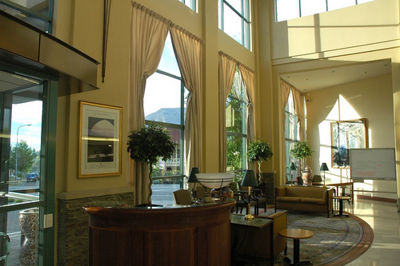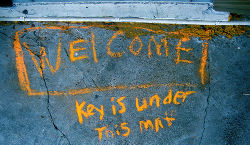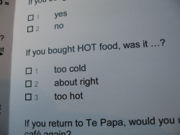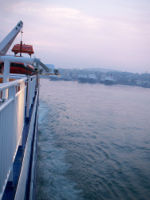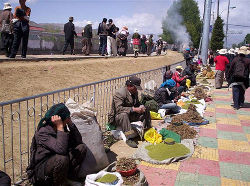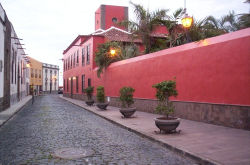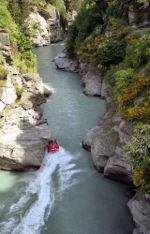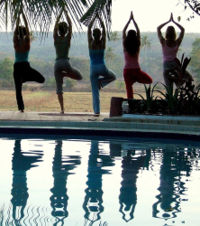Sales and Marketing1
| Course Blog |
|---|
- The ability to sell and market products and services in the tourism sector is highly valued, especially when combined with excellent customer service.
This is a course for learning or refreshing your skills in sales and marketing a tourism organisation. Below is a schedule for the course including a copy of the course outline, the topics, activities and assignments.
Otago Polytechnic will be running this course from 16 February - May. If you would like to join this course, please contact Hillary Jenkins.
People enrolled with Otago Polytechnic as students of this course have access to learning support services such as the libraries, the Community Learning Centres, regular contact with learning facilitators and lecturers, assessment services and certification.
Contents
Learning Objectives
1. Initiate and complete the process of buying and selling accommodation
2. Produce a spreadsheet for organisational use
3. Apply and service marketing and selling technques in a tourism context
4. Identifying and initiating excellent customer service practice
5. Analysing the process involved with marketing a destination [ Course Outline
Course Schedule
Following is a list of topics we will work through in this course. Each topic has a general introduction, followed by a list of activities to work through, and finally a list of links and resources you might use to work through the activities.
Otago Polytechnic's course weblog will pace you through these topics and put you in touch with teachers, other students and a range of other media and information. Use this schedule as a way to look ahead and prepare in the course.
Orientation and introductions
- Our first topic is to get to know the course, and the people involved in it. If you get lost later in the course, come back to this topic and use the activities to re orientate yourself to things. If you are still lost of confused, make contact with teachers or other students via the course weblog.
Business Travel
- The travel section of the Sales and Marketing course focuses on corporate travel management which is the facilitation of all aspects of travel for the business client, including reservations, loyalty schemes, negotiating and implementing corporate rates and managing travel and entertainment expenses.
- Who is the corporate traveller? Create a profile for the corporate traveller. For example: what is their gender, age, employed by what type of company?
- Compare leisure and business travel e.g. Who pays?, When do they travel?, Who travels? etc.
- Research tourism statistics and review the importance of business travellers to tourism.
- Research and evaluate the unique needs of a business traveller.
1. One of the main roles of the corporate travel manager is to negotiate special arrangements with the suppliers e.g. airlines, hotels, travel agents etc. Look at the link to the description of Corporate Travel Management for further understanding of the role.
2. The service level agreement between your nominated travel agency and your company is crucial to your success. What would you expect to be documented in an agreement?
3. View the promotionalvideo and prepare a Service Level Agreement. Examples of headings; Objectives, Reservations, Processing, Ticketing, Service hours, Account billing, technology. Now in groups of three (or individually) produce a document on the frequent flyer programmes offered by - airline accommodation, rental cars
4. As companies become more cost conscious and global, it is crucial that the management have a strong and cohesive travel management programme. Many issues face business travel decision makers when constructing their travel policy e.g. evaluating travel supplier relationships, airline, rental car, accommodation and travel agent or management company. They must balance cost against service levels to gain the best value for their company's travellers to support their business travel. Go to the activity link.
5. Establishing, developing and confirming business plans are the major components of the Business Travel Administrator's position. To be able to perform this function, you need to provide a means for obtaining all the information required. Research several travel request forms, and then develop a form which combines the best features of all you have perused. Remember, it must be easy for your corporate traveller to complete (not too time consuming) but still have all the details you may need.
6. Plan an overnight business trip within New Zealand and submit your requirements by completing one of your colleagues travel request form.
7. Corporate travel purchasing process is made within the context of the established travel policy.
The policy drives the preferred supplier agreements and controls the organisations spending. In the current financial climate, travel funding is an area where budgets will be tightened as it is one of the largest controllable company expenses.
Traveller compliance with the company's travel policy is now more strictly enforced and in some cases is either more restrictive e.g. by reducing number of trips taken, or by requiring more levels of authorisation.
8. New technology is changing the corporate travel world both from the administrator and the travellers (road warriors) point of view. The usage by the corporate traveller has well surpassed usage by the general public and enables instant confirmation, alteration and transfer of all travel information. The travel administrator can now log on to the travel management companies version of an online booking system to reserve their staff's travel bookings with the support of the travel management company e.g. Orbit Corporate Travel. Tourism suppliers e.g. Hertz are also making use of technology to improve travellers satisfaction.
9. Research and evaluation - the two go hand in hand. While you have been looking at research (forms of it) and statistics (results from it) in "destination marketing" and the ensuring affect on the marketing process. For business travel and selling, research and analysis or evaluation of it, is directly related to client satisfaction. Gathering quantitative (facts and figures) and qualitative (in-depth) information can assist with an organisation's ability to become and retain their excellence in being customer orientated. Look at this example of how this might work refer to PDF - Spotlight 4.3 on the student drive.
Some of the qualitative techniques used to gather information around customers include:
Personal interview: involves sitting with an individual and leading them through a particular topic area, via prompts (tool - questionnaire).
Focus group: involves meeting with a group and encouraging them to talk about a particular topic by leading them through a topic guide (tool)
Observation: involves watching a subject in a particular situation at a particular point in time
Tools: questionnaire, topic guide, recording
Whereas quantitative information needs are more easily met by:
Computer, mail, telephone, in street, in house, panel
Tools - questionnaire, survey
Air New Zealand use an online survey tool to monitor client satisfaction. Lets take some time to familiarise ourselves with this Canadian Corporate Travel and Leisure Agencyan excellent example of an organisation which offers a corporate travel package, right down to their Corporate Care Travel Evaluation Form designed to meet their commitment to excellence in customer service, product quality and value.
Your activity is centred around finding out what your customer needs are - the first step to customer satisfaction, by designing a 'tool' to use in conjunction with one of the techniques above.
National and Regional Tourism Organisations are also very interested in customer satisfaction, so how is this measured at a tourist destination level?
As part of your Task assessment you will have to design, distribute, collect and analyse results of customer satisfaction from a focus group specifically gathered for this task. Lets try and complete a draft for the first step (and maybe the most difficult) - a survey form. You should bring the draft to class next Wednesday.
Your assessment for 'business travel', is a series of tasks which range from Travel Request Acknowledgement, to Itinerary Preparation, to Itinerary, to Itinerary Alteration, to Travel Funding and Payment. All activities must be completed by Tuesday 17 November.
Selling
One of the most important aspects of a business is `making a sale' because if this does not happen you will have no customers and no revenue.In this unit we will look at what motivates buyers and what skills are required to turn their needs into sales.
1. What is the "tourism product"?. See if you can find some definitions. These are some of the products you may be asked to sell in the future. Tourism (encompassing hospitality) products have unique features associated with them. People may buy (or you may sell) a tangible product eg. bungy jump with associated photos and video. However the true value of the product lies in the intangible experience or how it made/makes them feel. Tourism products can also be associated with impacts which seldom affect other products social and cultural,economic, environmental. These are all part of the bigger picture surrounding tourism, but our focus is on selling the product so lets begin.
2. To be able to understand the selling process, you need to know who is involved in the tourism industry and what are their needs. View the presentation and complete the exercises. Motivation to buy is another aspect which you need to consider. We will look at four motives or factors for buying - personal, social, emotional and rational.
Personal - personal motives may include; purchase for self or others, gathering of information, identification of possibilities, self-gratification, self-reward, discovery of new trends, browsing, filling in time, physical activity, experience of sights, sounds, smells.
Social - social motives may include; meeting others; communicating with peer, hobby, age group; meeting personal and/or professional needs; gaining status, attention, respect; being served; experiencing a different environment from home, work.
Emotional - emotional factors may include; excitement, fun, gratification, vanity, anxiety, security, style, status, leisure, pleasure.
Rational - rational factors may include; necessity, value, durability, investment, knowledge, economy, quality, health, efficiency.
Researching motivation is an important step to learning about your customers. Complete this motivation exercise as part of your assessment.
3. Business to business selling is most important in any industry. In the business to business model, one company sells to another company, not to the public. e.g. A hotel sells meeting room to a conference company, charter airline leases an aircraft to a group tour organiser, insurance company insures a cruise line against mishaps, Movieworld sells tickets to a tour operator.
4. Hard sell situations are where one company sells a product to another. The tour operator may on-sell these products by either incorporating them in their own product (eg Trafalgar Tours including Greek Island ferries (operated by Super Fast Ferries) in their Greek Island Hopper tour.
5. Soft sell sales situations are when a business will visit another company to reinforce the relationship e.g. Sales representatives from airlines, cruise companies and tour operators visit travel agencies on a regular basis often inviting the staff for refreshments. They are selling the quality and expertise of their organisation.
6. The direct model of distribution is when the suppliers e.g. hotels, airlines, rental cars sell to the public, commonly known as retailing. The indirect method is where the suppliers sell via intermediaries e.g. tour operators, travel agents. In this method, the original suppliers are now wholesalers (sell something to a business for resale), and the intermediaries are retailers (selling direct to the public).
7.Identify at least three different terms used in the tourism industry to describe sales reps and summarise what their position would involve.e.g. Inform their clients about the products they represent.
8.Read the article Supply Driven vs Demand Driven Distribution and summarise the main points in your own words. priceline website
9. You are employed by the office of the National Tourism of Madagascar and you are required to design a package to promote Madagascar as a new destination. You will be presenting your information to a group of travel agents. Follow the link for details.
10. The salesperson operating in the 'Front line to the Public' position is the most familiar type of selling. e.g. rental car reservationists, travel agents, hotel reservation personel.
This interaction can be in person, by email, by telephone or occassionally by `snail' mail. Check your own Sales and Services IQ by completing the questionaire Selling can be divided into two main areas, either transactional or consultative. Transactional selling is where you make it possible for someone to complete the 'transaction' of buying a product or service. e.g. an airline seat. Where your client/customer requires more information or advice than simply purchasing a seat, you enter into a 'consultative' interaction. Asking questions and making recommendations requires more skills and understanding and will build a more valuable relationship with your client. This will lead to maximum profit and increased client satisfaction. To assess your own selling skills complete the Activity
11.`Welcoming' is one of the most important steps in the sales cycle. Think about your recent purchases - were they over the phone, in person or on the internet. All different modes of sales contact have welcoming aspects to them. View the first five slides on the power point and complete the exercise on Internetselling and Welcominga Client on the internet. The video will give you some ideas on how to judge a website.
'Determining Needs' is the section in the cycle where you use your 'interview' skills to ascertain if your customer is a browser, a shopper or a buyer. The questioning techniques include vanguard or closed-ended questions, explorer or open-ended questions and the most important skill of active listening. The [1] Activity] includes researching to fulfil the clients specified needs.
12. It is easy to fall into the habit of selling according to what your like and forget about your clients needs. In some instances, you are in the situation where there is no alternative. This is called an exclusive supplier relationship. e.g. Disneyland only sells Coca Cola. Think of another local example of this relationship. More frequently, the company may have a preferred supplier relationship. List the advantages this arrangement would have for a travel agent. Your clients will not always agree with your suggestions and there are several techniques which tourism specialists master to counter these objections. You can Paraphrase, Agree, Show and Seek (PASS) e.g. You think the tour is too expensive, I can understand that when you first look at the price it is above your budget, however, I am recommending this specific company because they include all your sightseeing and meals. Do you think this tour is now acceptable for your needs? The activity, Concerns will introduce another method of addressing clients concerns. Some clients are more difficult that others, view the short video for some insight.
13. Cross-selling and upselling are two very important strategies in selling. You may be drawn to a company because of an advertised product e.g. camera at a promotional price - this product is known as a loss leader. The company will make little or no profit on the camera and will hope to draw customers in where the salesperson can sell either additional, cross-selling, or more expensive, upselling, products. The above strategies are an integral part of selling in the tourism industry which operates on low profit margins. View the video and list opportunities in the tourism industry for cross-selling and upselling. Now look at the two activities one highlighting cross-sellingand one upselling.
14. The final step on the sales cycle is Achieving an Agreement. Unless you can convince your customer to buy, all you have done is provide service and information for free and they may purchase elsewhere. The final powerpoint will look at some traditional closers e.g. bear-trap close, and some better closing techniques.
15. In this final session, we will familiarise ourselves with the terminology and legislation which relates to the selling process in New Zealand. You must be aware of your liabilities under the following acts; Consumer Guarantees Act 1993, Fair Trading Act 1986, Privacy Act 1993, Sale of Goods Act 1908.
16. Your assessment for the sales module is in the form of a role play utilising all your sales techniques and knowledge of applicable legislation.
Accommodation
The accommodation section of the Sales and Marketing course focuses on buying and selling accommodation which is the facilitation of all aspects of reservation enquiries in a commercial hospitality environment, including rate information, room types, facilities, location, payment methods, customer services. At the completion of this section you will be able to take, amend and cancel reservations in the commercial accommodation environment.
1. In our first class session we will familiarise ourselves with the hospitality sector and in particular different types of accommodation. Take a look at the first exercise of this section.
2. There are many unique hotels around the world, they may cater for to specific customer requirements or hobbies. Check out your next activityso that you can share this with your fellow class members. Think about how important it is for hotels to market themselves to keep up with competition.
3. The front office of an accommodation establishment is seen as the hub of the hotel. This is often where a customer makes their first contact with the establishment. Think of the different ways this may happen.
4. There are four different stages to the guest cycle: pre-arrival, arrival, occupancy and departure. The front office team are part of each of the four stages. We will discuss what happens at each stage and the importance of each stage from both the guests perspective and the perspective of the host accommodation.
5. This is when a guest informs the hotel that they will be staying. Within this part of the course we will look at why reservations are important, their purpose (for the customer and accommodation establishment), differences between guaranteed and non guaranteed reservations. Many hotels offer guests a packagewhich may be made up of accommodation, transfers, food and beverage and activities. We will discuss the key objectives of the reservation department, the product and rates.
6. Many hotels today use computerised reservation systems that assist with taking reservations, maximising occupancy, yield and revenue as well as ensuring efficient systems. During this course we will use the property management system Fidelio that is used in many hotels through New Zealand and worldwide. We will also look at a manual system, if you are setting up a smaller accommodation establishment or if technology should fail!
7. When a customer books a room at a hotel, they will usually be given a confirmation number, this confirms that they have made a booking. They may be asked if they want to guarantee their booking, this will ensure that a room is available when they arrive at the hotel. Hotels have different reservation policies, dependent on different factors, such as location and price. Take time to complete the policy activity.
8. Within the hotel industry there is terminology (abbreviations and jargon) that is used. Some of this is used when making a guest reservation. We have already looked at the differences between a guaranteed booking and a non guaranteed booking, when 6pm release may be used. Terms such as upgrade, blacklist, overbooking, VIP, room status, DND, DNM, OOO may also be used. We also want to know details about our customers, their preferences so that we can either anticipate their needs or ensure excellent customer service when they stay with us, such details as MOP, ETA and ETD may be sought at the time of the reservation.
9. There are many forms of communication that are used within the front office and reservations setting (written, oral and non verbal). As part of your role in the front office you will be required to write to guests, potential guests and people external and internal in the hotel. All written communication, whether by letter, email, memo, fax or reports must be written effectively and professionally. Business letters are used to confirm a guests booking, as a response to an enquiry for a conference, as a welcome letter to the hotel and in some cases responding to a letter of complaint. A fax or email may also be used to confirm a guests booking. A memorandum (memo) is an effective method of communicating to a number of people at the same time. Take time to complete the correspondence activity.
Tourism Destination Marketing
This course looks at the concepts of marketing from a destination perspective. How Regional Tourism Organisations (RTO's) - market their areas, both domestically and internationally and the role and strategies in the marketing process of New Zealand's National Tourism Organisation, (Tourism New Zealand).
2. So how do we go about marketing a destination? Just what is a destination?
3. When we come to examine the external or macro environment there are several kinds of analytical tools which can be used. PESTELanalysis is an acronymn for Political, Economic, Socio-cultural, Technological, Environmental, and Legal. It is a useful strategic tool for understanding market growth or decline, business position, potential and direction. We will complete a PESTEL analysis for a local tourism operation in this session.
4. SWOT analysis an acronym for Strength, Weakness, Opportunity and Threats is often used when specifying objective/s for business ventures or projects and identifying the internal and external factors that are favourable and unfavourable to achieving these objective/s. Often points identified in a PESTEL analysis will turn up in the SWOT analysis . How would you complete a SWOT on a destination and why? Complete this exercise activity on Madrid using the matrix framework.
As part of your work for your tutorial next Tuesday look at a case study - "Marketing Belgrade as a conference destination". It can be found on the course drive - print it out and answer both questions 1 and 2.
5. Who are the organisations involved in marketing a destination? Tourism New Zealand is a crown owned entity and is the trading name for the New Zealand Tourism Board. Lets take a look at their Tourism New Zealand 2015 Strategy it will help with your first assessment (coming up).
6. Target Marketing is a business term meaning the particular market segment to which a product and/or service is marketed. A product focusing on a specific target market contrasts with one following the marketing strategy of mass marketing. Target marketing ensures more effective use of resources and allows the marketing mix (4P's) to be specifically developed to suit an identified group of customers. The marketer can then look for similarities in benefits that customers in the group are seeking. A market segment is a sub group of people (in our case) sharing one or more characteristic that cause them to have similar product needs. Segmentation can be a useful strategy when there are a number of competitors in the market place. Lets take a look at how TNZ identifies its target market and then look at one particular group of visitors - the interactive traveller.
Tourism New Zealand’s role is to market New Zealand off-shore as a desirable visitor destination. This is done through the 100% Pure New Zealand marketing campaign. Can you recognise any of characteristics of these segmentations apart from the obvious geography aspect? To help you with this complete this targeting activity.
7. Research - the systematic and objective search for information. How would you go about this? The Ministry of Tourism research website is the home of New Zealand's official tourism research programme. You can find all the latest tourism information here, from future forecasts to projects. So why place so much importance on statistics? Watch how statistics are used in this news item on tourism numbers from TV3 news. They are also one of the best ways to define who your target market is.
Lets take a look at how focussed research can pay off. Take a look at the Hillebrandwebsite and answer the following questions.
8. The marketing term "Positioning" and its ensuing strategies, looks at the position of the destination in relation to the marketplace and competitiors. It addresses issues such as how the destination is “perceived” by the market, an analysis of the products strength and weakness and how these can be compared to the threats and opportunities in the external environment, as well as the previous success of the destination shown in statistical reports.
Position is important, since marketing strategies are developed based on the kind of image the company or destination in this case expects to maintain in the eyes of the customer. What image does a destination such as Dunedin or Queenstown hold in the minds of current or potential visitors? Positioning Research can help decide the optimum positioning for a product. This refers to how the product fits into the market, what its image is or will be, and who is likely to buy it.
Terms such as:
- Market Leader - the destination with the largest market share whose strategies include expanding total market demand, defending market share against challengers and growing market share
- Market Challenger - poses a threat to market leader, already has a large market share, uses attacking stragies to beat the leader
- Market Follower - follows leaders, only wants enough of the market to be profitable, aims to maintain market share and defend against challengers, may copy leaders or challenges products. Should be considered when you are looking at setting positioning strategies.
Two other marketing strategies worth considering when looking at a destination are:
- Niche Marketing - where the product satisfies a specific segment only and one which is not catered for by larger destinations
- Relationship Marketing - where the tourists travel experience is constructed of products/destinations supplied by areas working in conjuction with each other.
9. Branding just how well has Tourism New Zealand done it? According to them marketing campaign really well. Lets compare it with the Australian campaign. What about a regional campaign? Dunedin did have the branding "I am Dunedin" introduced in 2001 and award winning in 2004 however it has not been used recently.
In your first assessment you will investigate this in more depth - using the marketing processes, techniques and strategies, we have been studying. This report is due in Friday, November 13, 2009 - my mailbox 1pm. You can get the report bound for a small sum at any of the printeries or we can do this in room H301.
This "how to" on report writing resource should help you to understand the format required for report writing. There is also an report writing outline on the student drive.
10. Regional Tourism Organisations (RTOs) are responsible for promoting their regions to domestic and international visitors. There are currently 29 in New Zealand and these vary in size, structure, and scope of the activities they undertake. Some are funded in part or in full by local council, others by annual membership fees. All 30 however, act as a bridge between tourism operators, national tourism bodies, and local and central government.
These organisations all have marketing objectives. Lets take a look at Tourism Aucklands and see how they market the regional area nationally and their involvement with Tourism New Zealand to market the region internationally. Dunedin has its own RTO - Tourism Dunedin. What connection does it have with the areas tourism operators?
New Zealand Trade and Enterprises also has funding available for regions who wish to implement specific initiatives, especially tourism. These initiative projected are often managed by the RTO, for example Northland Enterprise initiatives.
Your final assessment will be a conference paper analysing the marketing components of both a regional area (both domestically and internationally. This paper is due in my mailbox on Friday, November 20, 2009 at 1pm.
